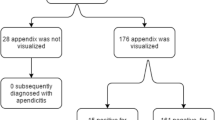Abstract
Background
Harmonic imaging (HI), a relatively new ultrasound modality, was initially reported to be of use only in obese adult patients. HI increases the contrast and spatial resolution resulting in artefact-free images, and has been shown in adults to significantly improve abdominal sonography. Regarding its application in paediatric patients, just a handful reports exist and these do not encompass its use in intestinal sonography.
Objective
To compare the sonomorphological image quality of HI and fundamental imaging (FI, conventional grey-scale imaging) in the diagnosis of histologically confirmed appendicitis in children.
Materials and methods
For this prospective comparative study, 50 children (male/female 25/25; mean age 9.9 years) suspected of having appendicitis were recruited. In all patients US examination of the appendix and periappendiceal region was performed preoperatively and appendectomy carried out. The final diagnosis was based on histological examination of the appendix. Both FI and HI were used in the US examination (tissue harmonic imaging, THI; Sonoline Elegra, Siemens; 7.5 MHz linear transducer). A detailed comparison of the images from FI and HI was performed using a scoring system. The parameters compared included delineation of the appendiceal contour, wall, mucosa, contents of the appendix and surrounding tissues. Furthermore, periappendiceal findings such as mesenteric echogenicity, free fluid, lymph nodes and adjacent bowel wall thickening were compared.
Results
In 43 children (86%) acute appendicitis was histologically confirmed. The inflamed appendix could be depicted in the HI and FI modes in 93% and 86%, respectively. HI was found to be significantly better for the depiction of the outer contour, wall, mucosa and contents of the appendix (P<0.01). This was also true for the demonstration of free fluid, mesenteric lymph nodes, adjacent bowel walls and mesenteric echogenicity.
Conclusion
HI should be the preferred modality for scanning the right lower abdomen in suspected acute appendicitis. The diagnosis of acute appendicitis can then be more definitely ascertained.









Similar content being viewed by others
References
Kaiser S, Frenchner B, Jorulf H (2002) Suspected appendicitis in children: US and CT – a prospective randomized study. Radiology 223:633–638
Pena BM, Cook EF, Mandl KD (2004) Selective imaging strategies for the diagnosis of appendicitis in children. Pediatrics 113:24–28
Puylaert JB (1986) Acute appendicitis: US evaluation using graded compression sonography. Radiology 158:355–360
Quillin SP, Siegel MJ (1994) Appendicitis: efficacy of color Doppler sonography. Radiology 191:557–560
Birnbaum BA, Wilson SR (2000) Appendicitis at the millennium. Radiology 215:337–348
Martin AE, Vollman D, Adler B, et al (2004) CT scans may not reduce the negative appendectomy rate in children. J Pediatr Surg 39:886–890
Shapiro RS, Wagreish J, Parsons RB (1998) Tissue harmonic imaging sonography: evaluation of image quality compared with conventional sonography. AJR 171:1203–1206
Bartram U, Darge K (2005) Harmonic versus conventional ultrasound imaging in the urinary tract in children. Pediatr Radiol 35:655–660
McMahon CJ, Fraley JK, Kovalchin JP (2001) Use of tissue harmonic imaging in pediatric echocardiography. Cardiol Young 11:562–564
Darge K, Zieger B, Rohrschneider W, et al (2001) Contrast-enhanced harmonic imaging for the diagnosis of vesicoureteral reflux. AJR 177:1411–1415
Rosendahl K, Aukland SM, Fosse K (2004) Imaging strategies in children with suspected appendicitis. Eur Radiol 14 [Suppl 4]:L138–L145
Kosloske AM, Love CL, Rohrer JE, et al (2004) The diagnosis of appendicitis in children: outcomes of a strategy based on pediatric surgical evaluation. Pediatrics 113:29–34
Hörmann M, Scharitzer M, Stadler A, et al (2002) Ultrasound of the appendix in children: is the child too obese? Eur Radiol 13:1428–1431
Kessler N, Cyteval C, Gallix B, et al (2004) Appendicitis: evaluation of sensitivity, specificity, and predictive values of US, Doppler US, and laboratory findings. Radiology 230:472–478
Kaneko K, Tsuda M (2004) Ultrasound-based decision making in the treatment of acute appendicitis in children. J Pediatr Surg 39:1316–1320
Hagendorf BA, Clarke JR, Burd RS (2004) The optimal initial management of children with suspected appendicitis: a decision analysis. J Pediatr Surg 39:880–885
Partrick DA, Janik JE, Janik JS, et al (2003) Increased CT scan utilization does not improve the diagnostic accuracy of appendicitis in children. J Pediatr Surg 38:659–662
Blab E, Kohlhuber U, Tillawi S, et al (2004) Advancements in the diagnosis of acute appendicitis in children and adolescents. Eur J Pediatr Surg 14:404–409
Dilley A, Wesson D, Munden M, et al (2001) The impact of ultrasound examinations on the management of children with suspected appendicitis: a 3-year analysis. J Pediatr Surg 36:303–308
Baldisserotto M, Marchiori E (2000) Accuracy of noncompressive sonography of children with appendicitis according to the potential positions of the appendix. AJR 175:1387–1392
Lee JH, Jeong JK, Park KB, et al (2005) Operator-dependent techniques for graded compression sonography to detect the appendix and diagnose acute appendicitis. AJR 184:91–97
Incesu L, Yazicioglu AK, Selcuk MB, et al (2004) Contrast-enhanced power Doppler US in the diagnosis of acute appendicitis. Eur J Radiol 50:201–209
Choudhry S, Gorman B, Charboneau W, et al (2000) Comparison of tissue harmonic imaging with conventional US in abdominal disease. Radiographics 20:1127–1135
Rosenthal SJ, Jones PH, Wetzel LH (2001) Phase inversion tissue harmonic sonographic imaging. AJR 176:1393–1398
Bauer A, Hauff P, Lazenby J (1999) Wideband harmonic imaging: a novel contrast ultrasound imaging technique. Eur Radiol 9:364–367
Yücel C, Özdemir H, Asik E, et al (2003) Benefits of tissue harmonic imaging in the evaluation of abdominal and pelvic lesions. Abdom Imaging 28:103–109
Rosen E, Soo M (20001) Tissue harmonic imaging sonography of breast lesions. Improved margin analysis, conspicuity, and image quality compared to conventional ultrasound. Clin Imaging 25:379–384
Darge K, Moeller R, Trusen A, et al (2005) Diagnosis of vesicoureteric reflux with low-dose contrast-enhanced harmonic ultrasound imaging. Pediatr Radiol 35:73–78
Author information
Authors and Affiliations
Corresponding author
Rights and permissions
About this article
Cite this article
Rompel, O., Huelsse, B., Bodenschatz, K. et al. Harmonic US imaging of appendicitis in children. Pediatr Radiol 36, 1257–1264 (2006). https://doi.org/10.1007/s00247-006-0313-0
Received:
Revised:
Accepted:
Published:
Issue Date:
DOI: https://doi.org/10.1007/s00247-006-0313-0




